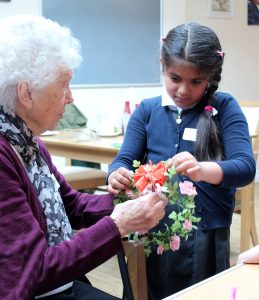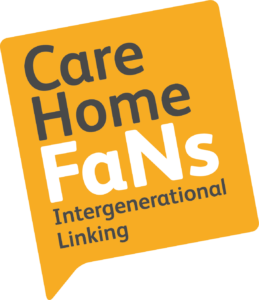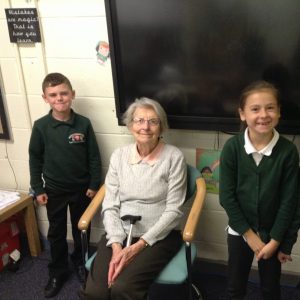Sustained connections: The lasting impact of Intergenerational Linking between schools and care homes
 From 2019-2023, our national social action project Care Home Friends and Neighbours (Care Home FaNs): Intergenerational Linking linked together more than 4,000 young people aged 5–14 from schools and youth groups with over 2,000 older adults living in care homes across England.
From 2019-2023, our national social action project Care Home Friends and Neighbours (Care Home FaNs): Intergenerational Linking linked together more than 4,000 young people aged 5–14 from schools and youth groups with over 2,000 older adults living in care homes across England.
At least 6,000 individuals from 230 organisations took part, including 116 schools and youth groups and 114 care homes, making it the largest intergenerational project of its kind.
The project was co-led by us at My Home Life England and our partners, The Linking Network, alongside a network of local organisations.
Assessing the Impact
18 months after the original funded project ended, we conducted a follow-up study.
Our research reveals sustained engagement between schools and care homes, development and embedding of the Intergenerational Linking model, and the long-term value of intergenerational connections in social care and education settings.
See the reportKey Findings
- Ongoing Intergenerational Links: We interviewed 7 local organisations and all continued to deliver Intergenerational Linking, with about 50% of the original school-care home partnerships still active.
- New Connections: Beyond maintaining the existing relationships, brand new partnerships between schools and care homes had emerged, extending the project’s impact to new audiences.
- In-Person Engagement: With the easing of COVID-19 restrictions, interactions had shifted from virtual to face-to-face, fostering deeper and more meaningful relationships.
- Positive Impact: Schools and care homes continued to engage due to the widespread mutual benefits for both younger and older people, including improved wellbeing, social connections and broadened understanding between generations, as well as the community engagement benefits for the institutions themselves.
- Supporting Institutional Priorities: Intergenerational activities had been cited as evidence in CQC reports, Ofsted inspections, and Religious Education frameworks, further embedding them into the lives of schools and care homes. Many of the local organisations had successfully gained additional funding for intergenerational work and incorporated intergenerational practice into their organisations’ visions, emphasising its strategic importance.
- The Fundamental ‘Broker’ Role: Local project leads (brokers) continue to play a crucial role in facilitating the school-care home connections, supporting, training and motivating staff, and ensuring the sustainability of links.
“There’s an appetite from care homes and there’s been appetite from schools… loads of schools wanted to get involved.”
“I just see so many layers of it that work really nicely … in terms of breaking down stereotypes of other people, bringing people together…it’s just about building connected communities.”
Learnings and Opportunities
- Face-to-Face Shared Interactions Enhance Impact: The post-Covid shift from virtual to in-person engagement has deepened relationships. Sessions designed as a shared experience between younger and older people continue to be the most effective, as they invite conversation and working towards a common goal.
- Broker Support Remains Crucial: Although some connections have developed to be self-sustaining, the broker role continues to be a necessary component, providing pro-active support, valuable guidance, and maintaining momentum when links face unexpected challenges.
- Multi-Level Support Structures are Key: The broker role has evolved to represent a trainer in intergenerational best practice and this model would benefit from more support, equipping teachers and care home staff with the knowledge and skills to drive forward effective, meaningful Intergenerational Linking. Also important is brokers working alongside fellow organisations for whom intergenerational practice is a key priority.
- Funding and Policy Integration: Continued investment and recognition in policy frameworks can help expand the reach and impact of intergenerational initiatives.
Impact on Participants
This follow-up study reaffirmed the profound impact of intergenerational connections seen in the original project. This included:
- For older people: Social interaction, enhanced quality of life, opportunities for knowledge exchange, and renewed sense of purpose.
- For younger people: Skill-share opportunities, active citizenship, friendship, joy, and exposure to different life experiences.
“One chap had joined the care home recently and hadn’t smiled. He didn’t want to be there, didn’t like it… And then, after visiting the children, he was smiling and chatting and talking”.
For the participating schools and care homes, Intergenerational Linking gave opportunities for community engagement, strengthened reputations and recognition in inspections. And for the local organisations, the project had led to new funding opportunities and was a catalyst to embed intergenerational practice into their core aims and work.
Conclusion
The original investment into intergenerational practice between schools and care homes has led to sustained impact.
The impact of Care Home FaNs: Intergenerational Linking is evident in the sustained relationships and ongoing engagement, the new connections and opportunities, the development of the model as it grows, the recognition in inspection frameworks and the embedded intergenerational practices across schools, care homes and local organisations. Intergenerational Linking continues to deliver wide-ranging benefits to younger and older people, to schools and care homes, to local organisations and wider communities, enriching lives, fostering understanding, and facilitating a stronger, more integrated society.
For more insights and resources, visit our original project page:
More about Intergenerational LinkingFor consultancy support with forming community connections, please get in touch:
Contact us


Care Home FaNs: Intergenerational Linking was originally funded through the #iwill Fund. The #iwill Fund is made possible thanks to £66 million joint investment from The National Lottery Community Fund and the Department of Digital, Culture, Media & Sport (DCMS). The Dunhill Medical Trust acted as a match funder for the project and we are grateful for their support.

